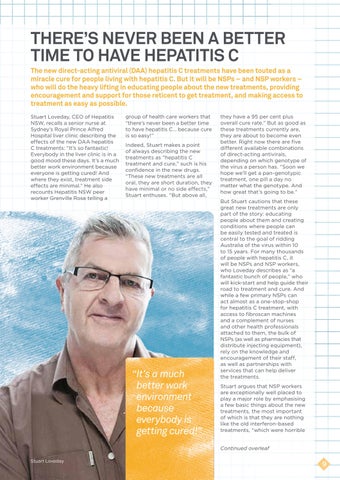THERE’S NEVER BEEN A BETTER TIME TO HAVE HEPATITIS C The new direct-acting antiviral (DAA) hepatitis C treatments have been touted as a miracle cure for people living with hepatitis C. But it will be NSPs – and NSP workers – who will do the heavy lifting in educating people about the new treatments, providing encouragement and support for those reticent to get treatment, and making access to treatment as easy as possible. Stuart Loveday, CEO of Hepatitis NSW, recalls a senior nurse at Sydney’s Royal Prince Alfred Hospital liver clinic describing the effects of the new DAA hepatitis C treatments: “It’s so fantastic! Everybody in the liver clinic is in a good mood these days. It’s a much better work environment because everyone is getting cured! And where they exist, treatment side effects are minimal.” He also recounts Hepatitis NSW peer worker Grenville Rose telling a
group of health care workers that “there’s never been a better time to have hepatitis C… because cure is so easy!” Indeed, Stuart makes a point of always describing the new treatments as “hepatitis C treatment and cure,” such is his confidence in the new drugs. “These new treatments are all oral, they are short duration, they have minimal or no side effects,” Stuart enthuses. “But above all,
“It's a much better work environment because everybody is getting cured!"
they have a 95 per cent plus overall cure rate.” But as good as these treatments currently are, they are about to become even better. Right now there are five different available combinations of direct-acting antivirals, depending on which genotype of the virus a person has. “Soon we hope we’ll get a pan-genotypic treatment, one pill a day no matter what the genotype. And how great that’s going to be.” But Stuart cautions that these great new treatments are only part of the story: educating people about them and creating conditions where people can be easily tested and treated is central to the goal of ridding Australia of the virus within 10 to 15 years. For many thousands of people with hepatitis C, it will be NSPs and NSP workers, who Loveday describes as “a fantastic bunch of people,” who will kick-start and help guide their road to treatment and cure. And while a few primary NSPs can act almost as a one-stop-shop for hepatitis C treatment, with access to fibroscan machines and a complement of nurses and other health professionals attached to them, the bulk of NSPs (as well as pharmacies that distribute injecting equipment), rely on the knowledge and encouragement of their staff, as well as partnerships with services that can help deliver the treatments. Stuart argues that NSP workers are exceptionally well placed to play a major role by emphasising a few basic things about the new treatments, the most important of which is that they are nothing like the old interferon-based treatments, “which were horrible Continued overleaf
Stuart Loveday
9






